Planting

Description
- Refers to the design and installation of topsoil, humus, fertilizer, mulch, and new plantings of trees, shrubs, groundcover, lawn. Planting provides shade during hot weather, mitigates wind in large open areas, reduces soil erosion and stormwater pollution, and is an important habit for songbirds and insects. Planting design provides areas for rest and refuge for residents and provides access to nature for residents and community members in areas often lacking parks and open outdoor spaces.
- The mature tree canopy at many NCYHA campuses is one of our greatest assets. It is virtually irreplaceable and contributes to the sustainability of New York City as a whole. Preservation and protection of these mature trees must be prioritized in all design and construction work. (Reference this doc: NYCHA_Urban_Forest.pdf)
Baseline
- Consideration should be given to balancing soft and hard materials to enhance the appearance and functionality of NYCHA campuses. Consideration should also include crime prevention and pest management where the problem exists. [CCG]
- Where possible a variety of planting should be incorporated into the grounds to minimize lawn in favor of perennials and trees. Planting design should vary by campus to help instill differences for various developments and give open spaces character. It ties together hard and soft materials to create pleasant and attractive open spaces. Easy to maintain plantings are preferred to allow ease of maintenance and preserve the appearance and upkeep of green open spaces which affects the perception of the community, resident pride in their home, and employee morale. [CCG]
- Variation across the campus is also important to favor different areas based on local geography, soil condition, and micro-climate. Landscape can be used to help residents and non-residents navigate campuses. Since landscaped areas cover over half of NYCHA grounds and provide access to green open spaces in areas of the city in need of greater access to open space. The social value of landscaped areas for residents is highlighted when residents become attached to them. Some campuses have named them, such as “Shadyside” in Brownsville or “Cherry Park” in Woodside, adding cultural identity to these areas. [CCG]
Stretch
- Designers are encouraged to include irrigation in planting projects where project budgets allow. In such cases specify plants that require 1–2 years of irrigation after planting.
- Irrigation systems should favor passive drip irrigation below the surface or running along the surface to reduce maintenance and water loss.
- Preference is for the use of native plants or plants well suited to the local micro-climate for water conservation. Designers are encouraged to specify plants that are non-invasive, attractive, low maintenance, diverse and non-invasive tree species adapted for present and future site conditions (e.g, planting salt tolerant species in areas prone to coastal flooding).
Strategies

Optimize Performance, Operation & Maintenance of Buildings, Systems & Assets

Innovate Adaptive & Resilient Solutions
Last Updated on March 12, 2025 at 1:58 pm
Downloads and Data
Details

















